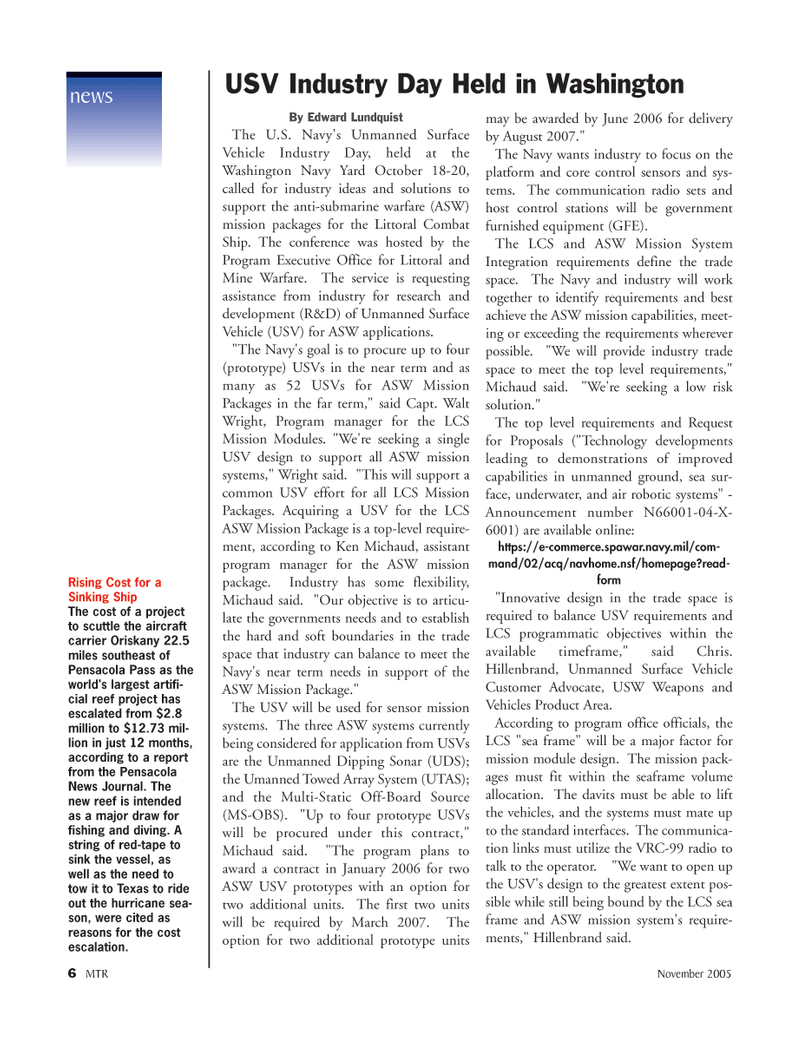
Page 6: of Marine Technology Magazine (November 2005)
Seafloor Engineering
Read this page in Pdf, Flash or Html5 edition of November 2005 Marine Technology Magazine
By Edward Lundquist
The U.S. Navy's Unmanned Surface
Vehicle Industry Day, held at the
Washington Navy Yard October 18-20, called for industry ideas and solutions to support the anti-submarine warfare (ASW) mission packages for the Littoral Combat
Ship. The conference was hosted by the
Program Executive Office for Littoral and
Mine Warfare. The service is requesting assistance from industry for research and development (R&D) of Unmanned Surface
Vehicle (USV) for ASW applications. "The Navy's goal is to procure up to four (prototype) USVs in the near term and as many as 52 USVs for ASW Mission
Packages in the far term," said Capt. Walt
Wright, Program manager for the LCS
Mission Modules. "We're seeking a single
USV design to support all ASW mission systems," Wright said. "This will support a common USV effort for all LCS Mission
Packages. Acquiring a USV for the LCS
ASW Mission Package is a top-level require- ment, according to Ken Michaud, assistant program manager for the ASW mission package. Industry has some flexibility,
Michaud said. "Our objective is to articu- late the governments needs and to establish the hard and soft boundaries in the trade space that industry can balance to meet the
Navy's near term needs in support of the
ASW Mission Package."
The USV will be used for sensor mission systems. The three ASW systems currently being considered for application from USVs are the Unmanned Dipping Sonar (UDS); the Umanned Towed Array System (UTAS); and the Multi-Static Off-Board Source (MS-OBS). "Up to four prototype USVs will be procured under this contract,"
Michaud said. "The program plans to award a contract in January 2006 for two
ASW USV prototypes with an option for two additional units. The first two units will be required by March 2007. The option for two additional prototype units may be awarded by June 2006 for delivery by August 2007."
The Navy wants industry to focus on the platform and core control sensors and sys- tems. The communication radio sets and host control stations will be government furnished equipment (GFE).
The LCS and ASW Mission System
Integration requirements define the trade space. The Navy and industry will work together to identify requirements and best achieve the ASW mission capabilities, meet- ing or exceeding the requirements wherever possible. "We will provide industry trade space to meet the top level requirements,"
Michaud said. "We're seeking a low risk solution."
The top level requirements and Request for Proposals ("Technology developments leading to demonstrations of improved capabilities in unmanned ground, sea sur- face, underwater, and air robotic systems" -
Announcement number N66001-04-X- 6001) are available online: https://e-commerce.spawar.navy.mil/com- mand/02/acq/navhome.nsf/homepage?read- form "Innovative design in the trade space is required to balance USV requirements and
LCS programmatic objectives within the available timeframe," said Chris.
Hillenbrand, Unmanned Surface Vehicle
Customer Advocate, USW Weapons and
Vehicles Product Area.
According to program office officials, the
LCS "sea frame" will be a major factor for mission module design. The mission pack- ages must fit within the seaframe volume allocation. The davits must be able to lift the vehicles, and the systems must mate up to the standard interfaces. The communica- tion links must utilize the VRC-99 radio to talk to the operator. "We want to open up the USV's design to the greatest extent pos- sible while still being bound by the LCS sea frame and ASW mission system's require- ments," Hillenbrand said.
USV Industry Day Held in Washington news 6 MTR November 2005
Rising Cost for a
Sinking Ship
The cost of a project to scuttle the aircraft carrier Oriskany 22.5 miles southeast of
Pensacola Pass as the world's largest artifi- cial reef project has escalated from $2.8 million to $12.73 mil- lion in just 12 months, according to a report from the Pensacola
News Journal. The new reef is intended as a major draw for fishing and diving. A string of red-tape to sink the vessel, as well as the need to tow it to Texas to ride out the hurricane sea- son, were cited as reasons for the cost escalation.
MTR#3 (1-16).qxd 11/15/2005 2:11 PM Page 8

 5
5

 7
7
